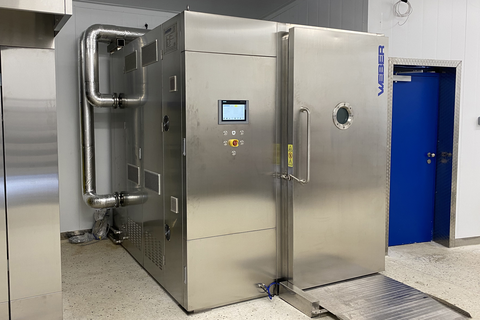Vacuum cooling is a technique that is gaining more and more interest among bakers
Weber Cooling is a leading manufacturer of vacuum cooling systems and provides complete cold chain solutions for vegetables, flowers, and other perishables. For several years now, the baking industry has also caught the attention of Weber Cooling.
Vacuum cooling is not new to the bakery industry. In fact, as far back as the 1960s, there were pioneers who dared to implement the technique in their production processes. Ultimately, the world was not yet ready for the technology, but the groundwork was laid. With current advancements, vacuum cooling is easier to integrate into the production processes of various industries, including the bakery sector. Weber Cooling has mastered the technique and developed affordable systems for the baking industry. We speak with Hans Juursema of Weber Cooling about the possibilities the company offers for the bakery sector.
Batch ovens and continuous ovens
"Vacuum cooling is a technique that is attracting more and more interest among bakers, both domestically and internationally," says Hans Juursema. "Most bakers have heard of it and know that a few bakeries in the Netherlands have one, but few are familiar with the technique behind vacuum cooling and the impact it can have on their bakery. That impact varies for each bakery but is fundamentally similar. It is important to make a clear distinction between batch ovens, where integrating vacuum technology is relatively easy to achieve in an existing setup, and continuous ovens, where integrating vacuum is often only worthwhile for completely new lines. Let's now focus on bakeries that use rotary or deck ovens."
The technology
"Vacuum cooling takes over part of the baking process, as steam formation - thus baking - continues in the cooler; it is the forced steam formation, caused by pressure reduction - creating a vacuum, that removes heat from the bread. It’s a complex subject, but the essence is that baking continues during cooling, shortening the oven time. Much more than expected - because a significant part of the oven time is needed to allow the bread to cool sufficiently stable, and this stability is no longer required with the vacuum cooler," Hans explains.
Benefits
It sounds very simple, but what are the benefits of vacuum cooling actually?: "Baked goods are very moisture-rich, and the steam formed during baking plays a crucial role in heat transfer, gelatinization of starch, and protein setting, and in forming the characteristic crust. Due to the high heat capacity of steam, steam also plays an important role in cooling. Baked goods emit steam, which carries away heat. When vacuum cooling, baked goods are placed in the vacuum chamber immediately after baking. Freshly baked bread contains enough steam, making it very suitable for effective vacuum cooling. Placing the product in the vacuum cooler cools it from the core outward. Steam naturally moves towards a cooler point, and under vacuum, the core of the product is cooler than the surroundings, drawing steam to the core. Lowering the pressure also lowers the boiling point of water, causing more steam to develop, which can again move to the cooler core. During starch gelatinization in baked goods (the cooking process), steam plays a crucial role, and during the vacuum process of baked goods, steam remains available longer, achieving deeper and more complete gelatinization, which can provide a longer-lasting softness of texture."
Realizable results
Hans continues: "In practice, the use of vacuum technology often leads to a 20% to 40% shorter baking time, applicable to virtually all bakery products, combined with a cooling time of an average of 2 to 3 minutes. And a product quality that is higher and a shelf life that is longer, provided the technology is optimally applied! It seems like magic and too good to be true, but practice shows that these benefits are truly achievable. For a baker, this can lead to shorter workdays, starting later in the morning, and generally higher productivity while optimizing their quality."
Odd one out
Seeing is believing is also the motto here, and adequate explanation and support are crucial. And this is precisely where Weber Cooling stands out as the “odd one out” when it comes to vacuum cooling for bakeries – in commitment. "Weber Cooling does not come from the bakery world and is therefore still unfamiliar to many. But as the world’s largest producer of vacuum coolers - according to our own claim - we know better than anyone how to build such a system affordably. In recent years, we have focused on optimizing the technology for the bakery world, and successfully so. We now have a full and very affordable range of vacuum coolers for use with rotary and deck ovens, which can be used in any bakery."
Seeing is believing
To demonstrate the possibilities and allow bakers to experience the benefits for themselves, there are several options to experience vacuum cooling. "We offer extensive support and testing facilities, with support from top-level (vacuum) bakers, such as from the Dutch Boulangerie Team, and by providing testing facilities in the Bakery Innovation Academy (BIA), where future bakers are also trained and educated. Small research vacuum coolers can also be provided, for purchase or rent. Post-COVID, 'Excellence Days' are planned, where groups of bakers can see for themselves at the BIA the positive effects vacuum technology can have on their bread. We believe we can make a positive contribution to many bakers in their production process and the quality of their products. We want to show that."
Contact
Via Teams, Zoom, or during a personal visit, the specialists at Weber Cooling are ready to see what they can do for you. For an initial introduction, you can contact Hans Juursema (0644 738 519 – hj@webercooling.com), partner and bakery specialist at Weber Cooling.


